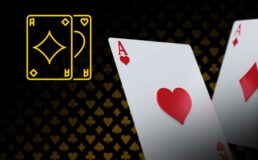The pair poker hand is one of the most common poker hands in the game, be it land-based or online poker.
Superior only to a high card, the one pair hand is far from the best possible hand, however, it can still be used to win a pot, granted that it is played well in the right circumstances.
In this blog, we at LV BET have explored the strength, probability and effectiveness of the one pair poker hand in the context of multiple poker variants, but especially Texas hold’em.
A PAIR IN POKER HAND RANKINGS
 Sitting below every other hand except a high card, the one pair ranks lower than a royal flush, a straight flush, a four of a kind, a full house, a flush, a straight, a three of a kind and a two pair.
Sitting below every other hand except a high card, the one pair ranks lower than a royal flush, a straight flush, a four of a kind, a full house, a flush, a straight, a three of a kind and a two pair.
If you want to find out more about traditional poker hand rankings, feel free to check out our dedicated blog.
The hierarchy of poker rankings typically follows this order in Texas hold’em poker games:
- Royal Flush: Ace, King, Queen, Jack, Ten, all in the same suit. For example, ace, K, Q, J and 10 is called a royal (straight) flush. This is the best hand that sits at the top of the hand rankings.
- Straight Flush: Straight flushes are made up of five consecutive cards of the same suit, but not the highest-ranking ones.
- Four of a Kind: Also called quads, this hand includes four cards ranked equally.
- Full House: Full houses comprise three cards of one rank and two cards of another rank.
- Flush: Five cards of the same suit, not in consecutive order. An ace, 10, 6, 3 and 2 of spades make an ace-high flush, since the ace is the highest-ranking card in the hand. A king high flush would be K, Q, J, 8 and 3 of clubs, for example.
- Straight: Five consecutive cards of different suits. (3, 4, 5, 6 and 7 makes a seven high straight). Ace to five makes an ace-high straight. A Broadway Straight refers to a 10 to A straight.
- Three of a Kind: Three cards of equal rank make a three of a kind. An example of a three of a kind is three aces.
- Two Pair: Two sets of pairs is called a two pair.
- One Pair: Two cards of the same value make a one pair. For example, two 10s make a pair. Pair hands lose to all poker hands except high card hands. A pair wins against lower-ranked pairs, as well.
- High Card: The highest card in your hand when no other combinations are present.
HOW IS A PAIR STRUCTURED?
The structure of a pair in poker is straight forward.
It comprises two cards of the same rank, along with three additional cards that are not of the same rank as the pair.
The rank of the pair determines the strength of your hand, with higher-ranking pairs being more valuable.
For example, if you have a pair of aces and three other cards that are not aces, you have the best pair possible.
If you hold a pair of sixes and three other cards that are not sixes, you have a pair of sixes — quite a mediocre pair.
PAIR IN POKER – THE CARDS SAME SUIT
Pairs in poker do not require the two cards to be of the same suit, in fact, this is impossible, since there is only one card of each rank in each suit.
Therefore, the suit of the cards in a pair does not affect the hand’s ranking.
All suit combinations are accepted as pair hands.
WHAT BEATS PAIR ON THE POKER TABLE?
One glance at the poker hand ranking chart shows that certain poker hands beat the one pair hand.
The poker hands are: royal flush, straight flush, four of a kind, full house, flush, straight, three of a kind and two pairs.
Although such hands will have the better of a pair, the one pair hand beats lower-ranked pairs and high cards.
IS PAIR IN POKER ALWAYS WORSE BETTER THAN STRAIGHT FLUSH?
 A one pair is undoubtedly worse than a straight flush.
A one pair is undoubtedly worse than a straight flush.
A straight flush is a rare and powerful hand that can never be beaten by a pair.
However, the value of your pair and the specific circumstances of the game can play a role.
For instance, if you have a pair of kings and a straight flush is not possible, your one pair can be a formidable hand.
Nevertheless, straight flushes always prevail over a pair.
WHAT IS A ONE PAIR HAND?
A “one pair” hand, as the name implies, is a poker hand consisting of one pair and three other cards that do not form a stronger combination.
The value of your one pair hand is determined by the rank of the pair.
For instance, if you have a pair of 10s and three other non-matching cards, you have a one pair hand with 10s.
PROBABILITY OF HITTING PAIR IN POKER
The probability of landing a pair hand in poker differs depending on the variant being played.
Here are the odds of making a one pair in Texas hold’em and Omaha.
MAKING A PAIR IN TEXAS HOLD’EM
In Texas Hold’em, the probability of hitting a pair primarily depends on the number of hole cards and the number of comm. cards available.
Let’s break down the key probabilities associated with landing a pair in this popular poker variant:
- Pre-Flop Probability: The initial probability of being dealt a pair as your cards in Texas Hold’em is approximately 5.88%. This means that, on average, you can expect to start with a pair about once in every 17 hands.
- Probability on the Flop: After the flop (the first three community cards are revealed), your chances of hitting a pair improve significantly. The probability of landing a pair on the flop, using one or both of your hole cards, is around 32.43%.
- Turn and River Odds: As the game progresses to the turn (fourth community card) and the river (fifth community card), your probability of hitting a pair increases further. The likelihood of hitting a pair on the turn is roughly 45.65%, while on the river (when all five community cards are in play), it climbs to approximately 47.83%.
MAKING A PAIR IN OMAHA
In Omaha, where you are dealt four cards and must use exactly two of them in combination with three of the five community cards, the probabilities of hitting a pair differ slightly from Hold’em.
Here’s an overview of the probabilities in Omaha:
- Pre-Flop Probability: The probability of being dealt a pair as your cards in Omaha is approximately 8.61%. This means that you are more likely to start with a pair in Omaha than in Hold’em.
- Probability on the Flop: Similar to Hold’em, after the flop is revealed, the likelihood of hitting a pair improves substantially. The probability of landing a pair on the flop, using one or both of your cards, is around 40.96%.
- Turn and River Odds: As in Hold’em, the turn and river provide additional opportunities to hit a pair. The probability of hitting a pair on the turn is roughly 53.06%, and on the river (when all five community cards are in play), it increases to approximately 54.35%.
PAIR IN POKER EXAMPLES
Let’s look at some examples of pairs in poker to understand their significance better:
- Example 1: You are dealt a pair of queens, along with three other cards that are not queens. This forms a one pair hand with queens.
- Example 2: Your hand consists of a pair of fives, along with three other cards that are not fives. In this case, you have a one pair hand with fives.
HOW TO PLAY PAIR IN TEXAS HOLD’EM AND OMAHA POKER
Knowing how to play a pair effectively is crucial in popular poker variants like Hold’em and Omaha.
Let’s explore strategies for both of these games.
PAIR IN TEXAS HOLD’EM
In Hold’em, pairs can be powerful, but their strength can vary based on comm. cards and your opponents.
Here are some tips for playing a pair in Hold’em:
- Assess the Comm. Cards: The comm. cards can significantly impact the strength of your pair, since the strength of a five-card hand is gauged by all five cards. Watch for possible straight and flush draws on the board.
- Bet Aggressively: If you have a strong pair, don’t be afraid to bet and raise to build the pot. However, be cautious if the board suggests potential stronger hands.
- Read Your Opponents: Pay attention to your opponents’ betting patterns and behavior. If they show signs of weakness, exploit it with well-timed bets.
PAIR IN OMAHA
In Omaha, where you are dealt four different cards, and you must use exactly two of them to make your best hand along with three of the five comm. cards, playing a pair can be a bit more complex.
Here are some considerations:
- Use Two Cards: Remember that you must use exactly two cards to make your hand. This means that with a pair, you’ll only be using two of your four different cards.
- Evaluate Combinations: Think about the possible combinations you can make with your cards and the comm. cards. Look for opportunities to create the best pair hand.
- Beware of Draws: Omaha often involves strong draws, so be aware of potential flush or straight draws on the board. Protect your pair from other players by betting and raising when necessary.
CONCLUSION – PAIR IN POKER AS PART OF YOUR STRATEGY
Once you start playing poker, you will realise how often a one pair poker hand will make an appearance in your poker game.
Seeing as a one pair is very common whenever you play poker, it is not deemed a strong five-card hand, which is why it will lose to most hands out there.
Nevertheless, understanding how to use pair hands against other poker players will amplify your chances of stealing the pot.
FAQ
✅ WHEN DOES PAIR IN POKER WIN?
A pair beats a lower-ranked pair or a high card and it draws to the same pair (different suits).
✅ WHAT IF TWO PLAYERS IN THE SAME HAND HAVE A PAIR?
In this case, the higher pair wins. For example, hand dealings of Q-Q-J-4-2 and Q-Q-7-6-5 see the former hand winning. The second pair takes the backseat since it is a lower pair.
✅ WHAT IS THE VALUE OF ACES IN PAIR?
Aces occupy the highest rank, which means that the best possible pair is two aces.
When you start playing your preferred poker variant, keep an eye out for aces both for making pairs and as a fifth card, which could be used as a kicker against other pairs.